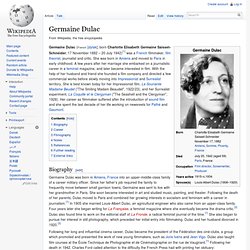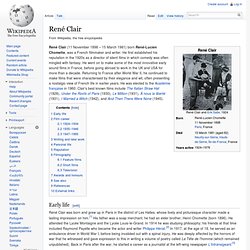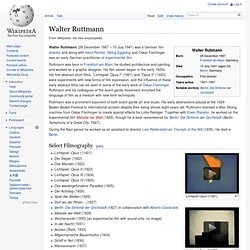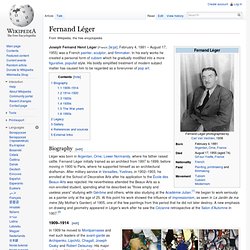

Luis Buñuel. Luis Buñuel Portolés (Spanish pronunciation: [ˈlwiz βuˈɲwel portoˈles]; 22 February 1900 – 29 July 1983) was a filmmaker who worked in Spain, Mexico and France.[2] When Luis Buñuel died at age 83, his obituary in the New York Times called him "an iconoclast, moralist, and revolutionary who was a leader of avant-garde surrealism in his youth and a dominant international movie director half a century later".[3] His first picture—made in the silent era—was called "the most famous short film ever made" by critic Roger Ebert,[4] and his last film—made 48 years later—won him Best Director awards from the National Board of Review and the National Society of Film Critics.[5] Writer Octavio Paz called Buñuel's work "the marriage of the film image to the poetic image, creating a new reality...scandalous and subversive".[6] Early years (1900–1924)[edit] During his student years, Buñuel became an accomplished hypnotist.

Un.Chien.Andalou.Luis.Bunuel.1929. Germaine Dulac. Germaine Dulac (French: [dylak]; born Charlotte Elisabeth Germaine Saisset-Schneider; 17 November 1882 – 20 July 1942)[1] was a French filmmaker, film theorist, journalist and critic.

She was born in Amiens and moved to Paris in early childhood. A few years after her marriage she embarked on a journalistic career in a feminist magazine, and later became interested in film. With the help of her husband and friend she founded a film company and directed a few commercial works before slowly moving into Impressionist and Surrealist territory. She is best known today for her Impressionist film, La Souriante Madame Beudet ("The Smiling Madam Beaudet", 1922/23), and her Surrealist experiment, La Coquille et le Clergyman ("The Seashell and the Clergyman", 1928).
Her career as filmmaker suffered after the introduction of sound film and she spent the last decade of her life working on newsreels for Pathé and Gaumont. La Coquille et le Clergyman (1926, Germaine Dulac) René Clair. Early life[edit] René Clair was born and grew up in Paris in the district of Les Halles, whose lively and picturesque character made a lasting impression on him.[1] His father was a soap merchant; he had an elder brother, Henri Chomette (born 1896).

He attended the Lycée Montaigne and the Lycée Louis-le-Grand. In 1914 he was studying philosophy; his friends at that time included Raymond Payelle who became the actor and writer Philippe Hériat.[2] In 1917, at the age of 18, he served as an ambulance driver in World War I, before being invalided out with a spinal injury. He was deeply affected by the horrors of war that he witnessed and gave expression to this in writing a volume of poetry called La Tête de l'homme (which remained unpublished).
Back in Paris after the war, he started a career as a journalist at the left-wing newspaper L'Intransigeant.[3] Entr'acte (1924) - Parte 2. Entr'acte (1924) - Parte 1. Man Ray. Man Ray (born Emmanuel Radnitzky, August 27, 1890 – November 18, 1976) was an American modernist artist who spent most of his career in Paris, France.

He was a significant contributor to the Dada and Surrealist movements, although his ties to each were informal. He produced major works in a variety of media but considered himself a painter above all. He was best known for his photography, and he was a renowned fashion and portrait photographer. Ray is also noted for his work with photograms, which he called "rayographs" in reference to himself.[1] L'Etoile de Mer (1928,Man Ray) Les Mystères du Château de Dé (1929, Man Ray) Emak-Bakia (1926, Man Ray) Man Ray : le retour à la raison. Marcel Duchamp - Anemic Cinema. Walter Ruttmann. Ruttmann was born in Frankfurt am Main; he studied architecture and painting and worked as a graphic designer.

His film career began in the early 1920s. His first abstract short films, "Lichtspiel: Opus I" (1921) and "Opus II" (1923), were experiments with new forms of film expression, and the influence of these early abstract films can be seen in some of the early work of Oskar Fischinger. Ruttmann and his colleagues of the avant garde movement enriched the language of film as a medium with new form techniques.
Ruttmann was a prominent exponent of both avant-garde art and music. His early abstractions played at the 1929 Baden-Baden Festival to international acclaim despite their being almost eight years old. Berlin: Symphony of a Great City [Act 1, Part 1] Ruttmann Opus IV 1925. Viking Eggeling. Four frames from "Diagonal-Symphonie" Biography[edit] Early career[edit] At the age of sixteen, the orphaned Eggeling moved to Germany to pursue an artistic career.

He studied art history in Milan from 1901 to 1907, supporting himself with work as a bookkeeper. Symphonie Diagonale Viking Eggeling. Hans Richter (artist) Hans Richter (April 6, 1888 – February 1, 1976) was a German painter, graphic artist, avant-gardist, film-experimenter and producer.[1] He was born in Berlin into a well-to-do family and died in Minusio, near Locarno, Switzerland.

Richter's first contacts with modern art were in 1912 through the "Blaue Reiter" and in 1913 through the "Erster Deutsche Herbstsalon" gallery "Der Sturm", in Berlin. In 1914 he was influenced by cubism. He contributed to the periodical Die Aktion in Berlin.[2] His first exhibition was in Munich in 1916, and Die Aktion published as a special edition about him. In the same year he was wounded and discharged from the army and went to Zürich and joined the Dada movement.
Richter believed that the artist's duty was to be actively political, opposing war and supporting the revolution. About Richter's woodcuts and drawings Michel Seuphor wrote: "Richter's black-and-whites together with those of Arp and Janco, are the most typical works of the Zürich period of Dada. " Hans Richter : Filmstudie. Hans Richter - Vormittagsspuk (1928) Hans Richter - Inflation - 1927. Hans Richter Rhytmus 21. Hans Richter - Rhythm.23. Fernand Léger. Joseph Fernand Henri Léger (French: [leʒe]; February 4, 1881 – August 17, 1955) was a French painter, sculptor, and filmmaker.

In his early works he created a personal form of cubism which he gradually modified into a more figurative, populist style. His boldly simplified treatment of modern subject matter has caused him to be regarded as a forerunner of pop art. Biography[edit] Léger was born in Argentan, Orne, Lower Normandy, where his father raised cattle. Fernand Léger initially trained as an architect from 1897 to 1899, before moving in 1900 to Paris, where he supported himself as an architectural draftsman. 1909–1914[edit] In 1909 he moved to Montparnasse and met such leaders of the avant-garde as Archipenko, Lipchitz, Chagall, Joseph Csaky and Robert Delaunay. In 1910 he exhibited at the Salon d'Automne in the same room (salle VIII) with Jean Metzinger and Henri Le Fauconnier. Léger's paintings, from then until 1914, became increasingly abstract. 1914–1920[edit]
Ballet mecanique (1924) Fernand Leger - Part 1. Ballet mecanique (1924) Fernand Leger - Part 2. La Folie Du Docteur Tube. Tristan Tzara. After moving to Paris in 1919, Tzara, by then one of the "presidents of Dada", joined the staff of Littérature magazine, which marked the first step in the movement's evolution toward Surrealism.

He was involved in the major polemics which led to Dada's split, defending his principles against André Breton and Francis Picabia, and, in Romania, against the eclectic modernism of Vinea and Janco. This personal vision on art defined his Dadaist plays The Gas Heart (1921) and Handkerchief of Clouds (1924). A forerunner of automatist techniques, Tzara eventually aligned himself with Breton's Surrealism, and under its influence wrote his celebrated utopian poem The Approximate Man.
During the final part of his career, Tzara combined his humanist and anti-fascist perspective with a communist vision, joining the Republicans in the Spanish Civil War and the French Resistance during World War II, and serving a term in the National Assembly. Name[edit] S.